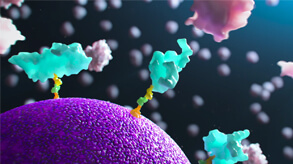Proteomic profiling for discovery of biomarkers and mechanistic insights into acute myeloid leukemia (AML)
Acute myeloid leukemia (AML) is a cancer of the blood and bone marrow that is characterized by the abnormal proliferation of immature myeloid cells. It is the most common type of leukemia among the adult population that accounts for about 80% of all cases1. AML is a complex, genetically heterogeneous disease, which presents challenges for treatment. Although most patients respond to standard intensive chemotherapy, approximately two-thirds of the patients relapse within 18 months to 5 years of the initial treatment2. The bone marrow microenvironment is thought to play a significant role in mediating the persistence of malignant leukemic stem cells. However, the exact nature of bone marrow–leukemic cell interactions is not well understood.
Combining proteomics and transcriptomics for a more comprehensive view
Multiomic studies can offer insights into the mechanism of AML persistence, including the effect of bone marrow microenvironment, identify prognostic biomarkers, and potentially aid in developing treatments that reduce the likelihood of relapse. Numerous genomic and transcriptomic studies have been performed to decipher the underlying molecular characteristics of AML. However, alterations on these levels do not always translate into molecular functions. On the other hand, proteomics can reveal the combined effect of genetic, transcriptomic, and epigenetic changes that could shed light on AML resistance and relapse.
High-plex proteomic assays and complementary mass spectrometry studies, in concert with genome and RNA sequencing, are a useful approach to understanding the mechanisms of disease, as they provide a more comprehensive look at the pathobiology by identifying protein biomarkers and protein networks associated with the disease. Proteomic studies are performed using biofluids such as bone marrow or blood, making them amenable for conducting longitudinal studies and monitoring disease treatment or reoccurrence. However, biomarkers are often low-abundance proteins which present a challenge for identification using mass spectrometry-based methods, especially in blood serum/plasma samples which are characterized by an extremely wide dynamic range of proteins3. For this reason, more sensitive methods, such as affinity proteomic assays, can provide enhanced depth to enable clinical insights.
The SomaScan® Assay identified a total of 168 proteins that were significantly dysregulated in the bone marrow plasma of patients with AML compared to that of healthy control subjects…
The paper by Çelik et al.,4 published in Blood Advances, describes a large-scale proteomic analysis of the changes in the AML bone marrow microenvironment. In this study, the bone marrow microenvironment of patients with AML was compared with healthy control subjects using the SomaScan® Assay. The researchers probed 1,305 target proteins from bone marrow aspirate using SOMAmer® Reagents (slow, off-rate modified aptamers) and identified specific biomarkers dysregulated in the bone marrow plasma of patients with AML compared to healthy control subjects. In addition, the study performed a comparative analysis using RNA sequencing (RNA-seq) of bone marrow aspirate cells and affinity proteomic assay of blood plasma serum, revealing signatures unique to the bone marrow proteome. The results of the study highlight the advantages of multiomic approaches for understanding complex diseases and the importance of using the appropriate methodology, as well as profiling the correct compartment for identifying appropriate disease biomarkers and gaining mechanistic insights.
SomaScan Assay identifies 168 proteins dysregulated in AML
The study was conducted by a research group led by Dr. Christopher S. Hourigan from the National Heart, Lung, and Blood Institute that focuses on developing immunotherapy approaches to AML treatment and is particularly interested in changes specific to AML. They performed highly multiplexed proteomic analysis using the SomaScan Assay along with in-depth bulk RNA-sequencing of whole bone marrow aspirate cells using the supernatant from bone marrow aspirates from 10 AML and 10 age- and sex-matched healthy control subjects. The results were published in a paper titled Highly multiplexed proteomic assessment of human bone marrow in acute myeloid leukemia.
The SomaScan Assay identified a total of 168 proteins that were significantly dysregulated in the bone marrow plasma of patients with AML compared to that of healthy control subjects, with 91 upregulated and 77 downregulated proteins found in leukemic bone marrow. The 168 differentially expressed proteins were sufficient to distinguish patients with AML from healthy controls using unsupervised hierarchical clustering analysis. Among the identified proteins, some had an established role in AML, while others had not been previously described. Notably, only 45 of the dysregulated targets were also identified by the RNA-seq of the bone marrow cells. Although transcriptomic analysis is a widely used method for identifying potential targets, RNA derived from intracellular sources may not reflect the extracellular proteomic composition of the bone marrow matrix.
The analysis found substantial overlap between the upregulated and downregulated protein pathways, suggesting a coordinated impairment of multiple regulatory mechanisms.
A network and cluster analysis revealed that the majority of upregulated proteins were connected by at least one association, which indicates that upregulated proteins in the leukemic bone marrow niche form large and complex protein interaction networks. The analysis found substantial overlap between the upregulated and downregulated protein pathways, suggesting a coordinated impairment of multiple regulatory mechanisms.
Disrupted chemokine and cytokine signaling is a prominent signature associated with AML
In addition to uncovering biomarkers, proteomic assays can shed light on the mechanisms of disease. In particular, the SomaScan Assay identified significantly elevated levels of chemokines, cytokines, and cytokine receptors in the bone marrow microenvironment. Pathway analysis showed that these proteins form a large and complex interaction network, with IL-8 playing a key role in the cytokine signaling. IL-8 levels were orthogonally validated by the SomaScan Assay and Luminex assay, confirming that this pathway may present an attractive therapeutic target for AML treatment.
Additionally, the analysis identified a novel upregulated AML protein represented in two isoforms. The myelosuppressive chemokine MPIF-1 (myeloid progenitor inhibitory factor-1), also known as CCL23 or CKβ8, is elevated in both AML and myelodysplastic syndrome patients, suggesting its role in the suppression of normal hematopoiesis.
Pathway analysis showed that these proteins form a large and complex interaction network, with IL-8 playing a key role in the cytokine signaling. IL-8 levels were orthogonally validated by the SomaScan Assay and Luminex assay, confirming that this pathway may present an attractive therapeutic target for AML treatment.
Among the downregulated pathways were proteins involved in the neutrophil degranulation and platelet function, previously known to be impaired in AML. Increased TIM-3, CD84, and LAG-3 inhibitory immune checkpoint molecules were seen on the RNA and protein levels in leukemic bone marrow. The immune system suppression is a known hallmark of cancer and has also been identified in other proteomic studies of AML5.
Conclusion
This study demonstrates how the SomaScan® Platform addresses the current challenges associated with cancer biomarker discovery and detection3. Compared to other proteomics methods, the SomaScan Assay enables fast, accurate, specific, and sensitive screening across a wide dynamic range of 10 orders of magnitude, due to the high binding affinity and selectivity of the SOMAmer Reagents. This assay is capable of detection of 7,000 proteins in just 55 µL of plasma or serum in a highly multiplexed fashion. The SomaScan Assay provides rich data that can be used to enhance genomic and transcriptomic analyses and enables identification of proteins and protein networks for mechanistic insights into difficult-to-treat cancers such as AML.
References
- Vakiti A, Mewawalla P. Acute Myeloid Leukemia. StatPearls (StatPearls Publishing, 2022) doi: https://www.ncbi.nlm.nih.gov/books/NBK507875/
- Yilmaz M, Wang F, Loghavi S, et al. Late relapse in acute myeloid leukemia (AML): clonal evolution or therapy-related leukemia? Blood Cancer Journal 9,7 (2019). doi.org/10.1038/s41408-019-0170-3
- Bhawal R, Oberg AL, Zhang S, Kohli M. Challenges and opportunities in clinical applications of blood-based proteomics in Cancer. Cancers, 12, 9 (2020). doi.org/10.3390/cancers12092428
- Çelik H, et al. Highly multiplexed proteomic assessment of human bone marrow in acute myeloid leukemia. Blood Adv. 4, 367–379 (2020). doi.org/10.1182/bloodadvances.2019001124
- Stratmann S, et al. Proteogenomic analysis of acute myeloid leukemia associates relapsed disease with reprogrammed energy metabolism both in adults and children. Leukemia 1–10 (2022). doi.org/10.1038/s41375-022-01796-7
More blogs
BlogHow Blood Proteomics Is Accelerating Neuro Drug Discovery
Explore how researchers are using blood-based proteomics – including data from the Global Neurodegeneration Proteomics Consortium (GNPC) – to uncover new protein signatures, genetic risk associations and mechanistic insights into aging and neurodegeneration.
BlogGNPC Neurodegeneration Proteomics Dataset
On July 15, 2025, the Global Neurodegeneration Proteomics Consortium (GNPC) published four open‑access papers unveiling the largest disease‑specific proteomic resource ever assembled.
BlogIndependent study validates the SomaScan Assay as the most precise and comprehensive plasma proteomic platform
A recent independent study by Alkahest, published as a preprint on bioRxiv1, compared the technical precision and performance of multiple plasma proteomic platforms using a common set of samples.





